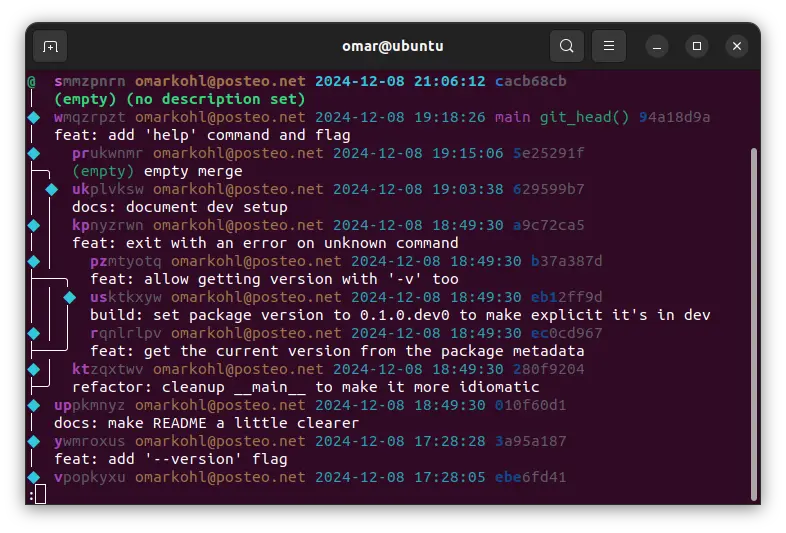Setup
Installation
Start by installing jj, following the installation
instructions.
Verify the installation was successful:
jj version
jj 0.24.0-32d2a85539254e9d96f9819072fa5c6ac70dd1e4
jj -h
Config
Basics
Set some global (for your user) configuration. Adapt as needed.
# Note if you have an EDITOR env variable you can skip this
jj config set --user ui.editor vim
## To copy the setting from Git use the following instead:
#jj config set --user ui.editor "`git config --get core.editor`"
jj config set --user user.email ME@EXAMPLE.COM
jj config set --user user.name "MY NAME"
## To copy the settings from Git use the following instead:
#jj config set --user user.email "`git config --get user.email`"
#jj config set --user user.name "`git config --get user.name`"
Make jj default to jj log, which is very convenient. Otherwise you'll have
to type jj log instead of jj every time you want to see the history, which
is frequently.
jj config set --user ui.default-command log
If you are inside a repository, you can set configuration that only applies to
that repository. Use --repo instead of --user.
(Optional) Make "log" more verbose
jj config get revsets.log
jj config set --user revsets.log '"present(@) | ancestors(immutable_heads().., 7) | present(trunk())"'
(Optional) Manually edit the config file
jj config path --user
jj config edit --user
Clone Repository
jj git clone --colocate https://github.com/omarkohl/jj-tutorial
cd jj-tutorial
--colocate allows you to use both Git commands and Ju Jutsu commands in the
same repository. If you don't use that option then Ju Jutsu will still keep an
internal Git repository inside the .jj/ directory but you will not be able to
execute any git ... commands yourself.
jj

(Optional) Try it in another Git repository
If you have any local Git repository I encourage you to try using jj in it too:
cd path/to/my/repo
jj git init --colocate
Now you can use jj with all the things you learn in this tutorial.
If you ever want to get rid of jj in this repository:
cd path/to/my/repo
rm -rf .jj/
That's it, as if jj had never been there! Any commits you created, rebased
etc. via jj will of course be there since jj synchronizes the jj data
with Git. It will just look as if everything had been done with Git.
(Optional) Shell completion
If you use bash, you can add the following to your ~/.bashrc:
source <(jj util completion bash)
See more examples for other shells.
(Optional) Live 'jj log'
A convenient way of permanently seeing the current state of your log is to run this command in a separate terminal window and have it open next to your work.
cd path/to/repo
watch --color jj --ignore-working-copy log --color=always
See an explanation and alternatives here.
Takeaways
Key points. As QA because of active recall. Try to come up with the answer yourself before looking 😉
- Questions
- Answers
- What is the relationship between Ju Jutsu and Git?
- If you forget about a particular command, how do you refresh your memory?
- Ju Jutsu stores everything inside a
.jj/directory, including an internal Git repository. Additionally, if your repository is colocated then the top level will also be a Git repository. Both Ju Jutsu and Git commands can then be used. Ju Jutsu makes sure to synchronize data bidirectionally. If you ever want to stop using Ju Jutsu in a repository you can just delete the.jj/directory. - Use
jj -h. To get more information for a particular command e.g.configusejj config -hor for even more information eitherjj config --helporjj help config.